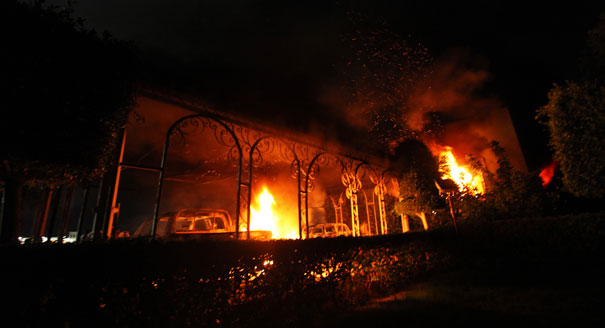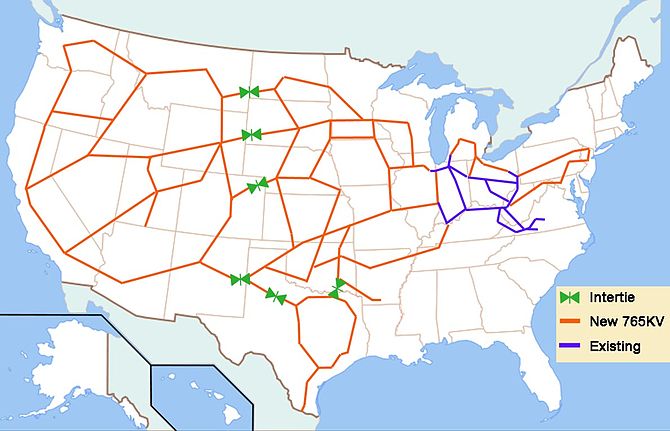Dinner with Dr. Arjun Makhijani in Red Wing
March 3rd, 2015
After listening to his testimony today before Minnesota’s Senate Environment and Energy Committee…
Video (weird write up, omitted the most important witness!!!), see 10:06:
*Lifting Moratorium on New Nuclear Power Plants
Arjun Makhijani – Minnesota Senate E and E Committee 03-03-2015
… we got another dose when Dr. Makhijani graced us with his presence at Fiesta Mexicana, with tales of Nuclear Waste Confidence that lit up every burn-up and zircaloy cladding wonk around the tables! It’s really depressing stuff, so it was better to discuss this dreadful and so unbelievable nuclear situation in a dedicated misery-loves-company group.
In his testimony, he’d brought up the dangers of moving forward with nuclear plans where there is “Construction Work in Progress” for utilities to recoup funds spent on construction long before it is in-service, if ever, as is happening with the Vogtle plant. So I took a stroll through our statutes, long familiar with our 2005 Construction Work in Progress give-away to Xcel on transmission, and found that, sure enough, it is an option for Minnesota utilities:
Minn. Stat. 216B.16, Subd. 6a. Construction work in progress.
(2) the impact on cash flow and the utility’s capital costs;
(3) the effect on consumer rates;
(4) whether it confers a present benefit upon an identifiable class or classes of customers; and
Xcel did finally come out and admitted their support for removal of the nuclear moratorium. When considered in light of their e21_Initiative_Phase_I_Report_2014, there’s a trajectory that I see, and wish I didn’t: Xcel could build a new nuclear plant on the ratepayers dime and sell it on the market using their new transmission that we’re paying for, making Minnesota an electricity exporter!
Tonight, we discussed the Nuclear Waste Confidence decision, which is a “No-Confidence” decision, the word “confidence” has been removed from NRC lexicon. Well, there is that other meaning of “confidence” to consider…
So on that happy note, I’ll have mango margaroodie dreams about the Pt. Beach cask explosion and the current task of changing the seals on those 20 year old TN-40 casks!
NUCLEAR?!? What is the Minnesota Senate thinking?
March 2nd, 2015
That’s “our” reactor, the Prairie Island Nuclear Generating Plant, here in Red Wing, it’s within the city limits (which were expanded to include the plant). I represented Florence Township from 1995, when Xcel, f/k/a NSP, applied to put nuclear waste in Florence Township under the “alternate site mandate,” and that went on, and on, and on, until they finally withdrew their application at the NRC in … what, 1999? 2000? That’s one I thought would never end. But that’s the thing about nuclear, it’s never over.
QUICK — CONTACT THE LEGISLATORS AT THE BOTTOM OF THIS MISSIVE.
There are two bills before the Senate Environment and Energy Committee TOMORROW:
- SF306 is simply worded, deleting the Minn. Stat. 216.243, Subd. 3b prohibition of new construction of a nuclear plant and changes it to “Additional storage of spent nuclear fuel” and over the previous language that states: “Any certificate of need for additional storage of spent nuclear fuel for a facility seeking a license extension shall address the impacts of continued operations over the period for which approval is sought.” It’s authored by Kiffmeyer, coauthored by Dahms and Anderson.
- SF0536 is even worse, authored by Anderson only (see also HF338 sponsored by O’Neill ; Newberger ; Garofalo ; Howe ; Baker ; McDonald ; Nornes). SF0536 lists only Anderson as an author, and, well, “Let’s build a nuclear plant!” Here’s the language:
 So we have a blanket repeal of the nuclear construction prohibition, and a specific opening for a Certificate of Need for a nuclear generator at the Monticello site.
So we have a blanket repeal of the nuclear construction prohibition, and a specific opening for a Certificate of Need for a nuclear generator at the Monticello site.
Authors contact info is linked above, and emails for Senate Energy committee members and the authors are also listed below.
Whether it’s targeted as a replacement for the Fukushima Daiichi style GE plant, or whether it’s to add and operate a second reactor, WHY?
First, there’s no need. There is a glut of electricity, as our friend, Xcel’s Ben Fowkes said, when they could no longer keep up the GROW GROW GROW fiction. Here’s the Seeking Alpha transcript of the XEL Earnings Call, January 31, 2013.
For last year:
From Xcel’s IRP (Docket 15-21), p. 45 of 102:
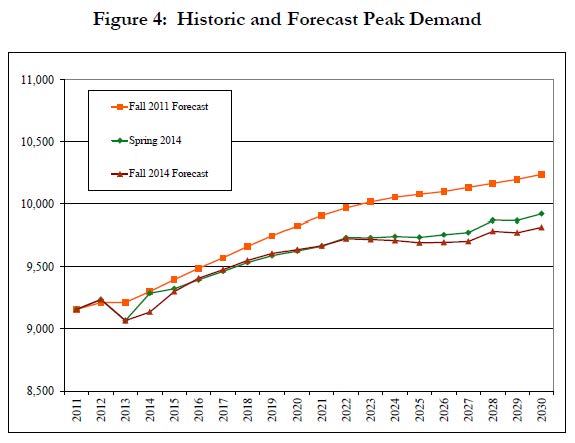 And here’s what they had to say about that (note they do NOT go back further than 2011, so we don’t get to see the 2000-2010 numbers):
And here’s what they had to say about that (note they do NOT go back further than 2011, so we don’t get to see the 2000-2010 numbers):
We forecast a period of relatively flat growth such that our median base peak will increase only 0.4 percent in each year of the planning period…
That chart is NOT consistent with the 2014 SEC 10K filing, which shows a 2014 peak demand of 8,848 MW (info below is linked, see p. 9 at 10-K link):
That lower number is consistent with the downward trend of the 2014 NERC Long Term Reliability Assessment, now showing growth rates at lowest levels on record (note that it has NEVER been close to the CapX 2020 “forecast” of 2.49% annually):
And here’s the picture for MISO from the 2014 NERC Long Term Reliability Assessment:
2014 NERC Long Term Reliability Assessment, p. 38 (or p. 46 of 115 pdf).
Also from the 2014 SEC 10-K link:
 |
|
So we don’t “need” it, there’s no talk of a new nuclear plant in their recently filed IRP. So why???
And the “WHY?” may be clearer when taken into context with last week’s hearing at House Energy, where the intent, in part, behind legislation there was to make Minnesota an exporter of energy. Again, WHY? Why make the state an exporter of energy? And if we do what would that do for our rates here? How does that fit with Xcel’s well funded plan to institute its e21 Initiative, and how does that fit with Xcel’s desire to use ratepayer money to find other market options? The House bill would let natural gas plants be built without a Certificate of Need, whether by an IPP or regulated utility, with the key being that they are selling into the MISO grid, and not for Minnesota native load.
But nuclear is SO expensive! First, there’s an immediate example of nuclear construction cost overruns right here in Minnesota, at the Monticello nuclear plant, where they went way beyond what was approved in the Certificate of Need:
Xcel management blamed for cost overruns at Monticello
So what was that about? Costs more than doubled, increased by a factor of 2.33!!! From the article:
And let’s look at new construction, the first new nuclear plant in the US in 30 years:
C&U disputes Southern Co. claim for $247 million in penalties for cost overruns at Plant Vogtle
The cost punchline on the Vogtle plant? Southern, Westinghouse and CB&I are already in court over previous cost overruns on the project, which is currently expected to cost $14.5 billion.
Here’s that other project:
Shaw Power Group, Westinghouse, face cost issues at S.C. project.
The cost punch line here? The NRC is expected to act soon on the Summer license. Summer is projected to cost about $9 billion.
Building new plants? Well, NEI has some info, BUT it’s outdated, nuclear has not caught up, and this is the most current I can find on the site (HERE’S THE WHOLE REPORT):
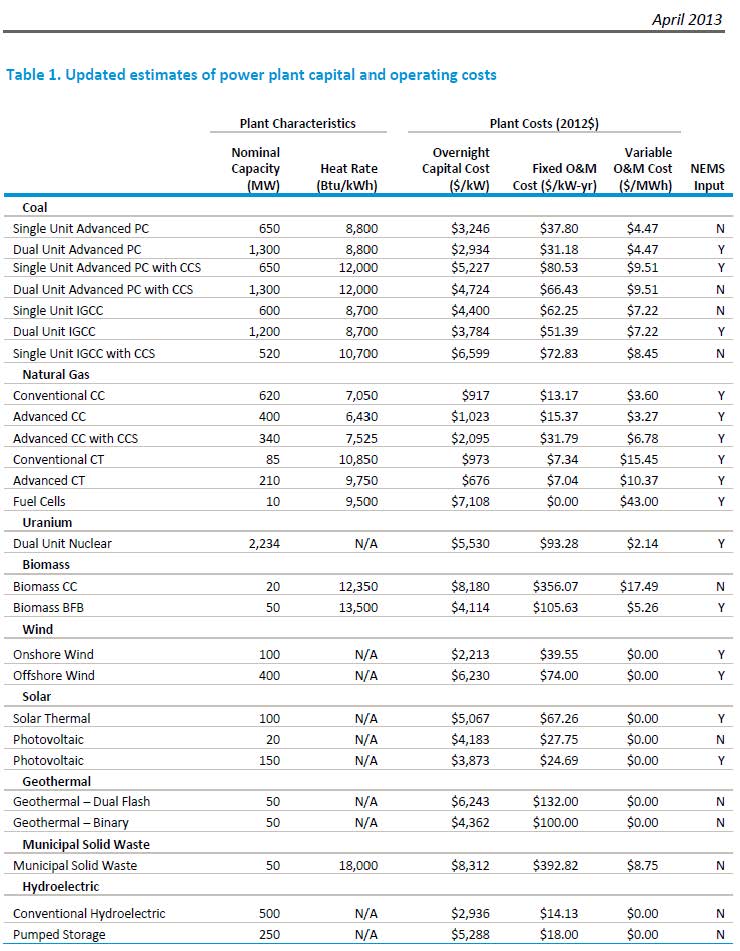 So please explain — why would anyone want to build a new nuclear plant?
So please explain — why would anyone want to build a new nuclear plant?
- There is no need.
- They cost so much that it’s unreasonable to even consider, and is the definition of imprudent!
Why are Reps. Kiffmeyer and Anderson trying to make this a possibility? Is this for real? Is it a diversion from some other issue?
CONTACT INFO FOR LEGISLATORS:
To contact the Senate Energy and Environment Committee, go to COMMITTEE LINK, because many MN Senators have form access, not direct emails. Boo-hiss… Here are the emails listed, but go to link to see the buttons for the Senators with form access only:
sen.john.hoffman@senate.mn; sen.david.osmek@senate.mn; sen.michelle.benson@senate.mn; sen.david.brown@senate.mn; sen.lyle.koenen@senate.mn; sen.julie.rosen@senate.mn; sen.bev.scalze@senate.mn; sen.matt.schmit@senate.mn; sen.bill.weber@senate.mn
Senate authors: sen.mary.kiffmeyer@senate.mn; sen.gary.dahms@senate.mn; sen.bruce.anderson@senate.mn
SF306 is authored by Kiffmeyer, coauthored by Dahms and Anderson, click names for links!
SF0536 is authored by Anderson only.
HF338 is sponsored by O’Neill ; Newberger ; Garofalo ; Howe ; Baker ; McDonald ; Nornes, click names for links!
Xcel Energy’s IRP “Stakeholder” meeting
February 10th, 2015
Today is the Xcel Energy “stakeholder” meeting for “stakeholders” at the PUC. For the IRP docket, CLICK HERE and search for PUC Docket 15-21.
Here are their scenarios:
Regulatory process and timeline. January 2 filing, 900 pages, and today between that filing and March 16, 2015 filing. That March 16 filing will be next piece and will complete filing of plan to Commission, then forward with Information Requests and stakeholder meetings, and then PUC decision within next year or so, depending on what’s happening in stakeholder process. Three components:
1) CAPCON Order (capacity acquisition process)
- Aurora Solar
- Calpine combine cycle expension
- Black Dog 6 Natural gas
2) Increase small solar forecast
3) Sherco Retirement Scenario
- Sherco 1 & 2 retirement in 2020
- Sherco 1 retirement in 2020, Sherco 2 retirement in 2023 (based on capacity acquisition process, retirement, etc. scheduling)
For questions about the IRP, contact Jim Alders james.r.alders@xcelenergy.com
This is on the heels of last night’s meeting of “Citizens League Electric Energy” group. From the Citizens League site:
- Read the Electrical Energy Phase I Report
- Read the Electrical Energy Phase 2 Report
And notes from committee meetings:
The January 26 meeting isn’t posted, but I scanned them in and will post later. They had a charge of the “committee” in the Phase 2 Report to support Xcel Energy’s “e21 Initiative” below:
That charge contained this specific direction:
… the Citizens League Study Committee will be asked to draft both a statement and legislation to direct the Public Utilities [Commission] to convene this public dialogue with the support of external stakeholder efforts.
So we shouldn’t have been surprised… That charge was pretty much fulfilled and presented to the group last night, BUT the good news is that in addition to Alan and my objections to that endorsement of the “e21 Initiative,” there were several long-time Citizens League members who objected to the way that this was done and the endorsement of the e21 Initiative. (I’ll insert the draft when I get back)
Short version, the Draft was soundly rejected. WHEW!
And for those concerned about this e21 Initiative, Intervene!!! Yes, Citizen’s League, that’s something YOU can do!
Just filed Petition for Intervention in Xcel’s e21 Docket
February 4th, 2015
Benghazi? Oh, please… read the report!
November 29th, 2014
Benghazi is a problem, but not the way so many loudly believe. The House of Representatives released their report a week ago, and those ranting need to read this. As the report notes:
Despite the highly sensitive nature of these activities, the report has endeavored to make the facts and conclusions within this report widely and publicly available so that the American public can separate the actual facts from the swirl of rumors and unsupported allegations.
Is reading the report expecting too much? Perhaps it is too much, given that the House report won’t substantiate the frenzy. So much wasted time, effort and money. Oh well… they’ll take up some other unsupported allegations and run with that for a while…
House of Representatives Permanent Select Committee on Intelligence Final Benghazi Report
And for those who don’t want to bother to read it, here’s the conclusions:
Investigative Report on the Terrorist Attacks on U.S. Facilities in Benghazi, Libya, September 11-12, 2012
Look what AWEA wants for us!
November 1st, 2014
There’s the Forbes article about American Wind Energy Ass (AWEA) advocating for this massive mess of new 765 kV lines.
Experts: Reducing Carbon Emissions and Increasing Grid Reliability are Doable
Experts? Ummmm, AWEA? No, they are NOT transmission experts, they are only expert in doing what their masters pay them to do. Here’s their “vision” from a couple of years ago:
Report – Update to the Superhighways report that AWEA’s Michael Goggin wrote in fall 2013.
In Minnesota, there’s one paralleling the CapX 2020 line, then another cutting the state in two from Big Stone to the Metro, and another from Split Rock to Adams along I-90. Who the hell do they think they are to advocate for this overkill of transmission? And note that in the Dakotas, as always, they start at the big coal plants. Infrastructure like this is the best way to assure coal never shuts down, adding capacity instead of shutting coal down and using that capacity. And if they do it this way, then they can run our coal plants forever. Oh, right… this is the plan AEP supports.
First and foremost, remember that this is about economics — money and profit from building transmission and providing transmission service — the grid IS electrically reliable, so says NERC in its latest State of Reliability 2013 Report:
And here’s the NERC Report (one should be due out soon, used to be October, but they’ve pushed it back):
What strikes me is that so many are willing to believe that the electric grid is not “reliable” and are willing to attribute economic issues like “congestion” to claims that the system is not reliable. And then there’s their successful effort to shift cost allocation so that the generators no longer pay for transmission necessary to access and safely operate the grid. In the past, generators paid, but then in the gas plant surge over a decade ago, so many were built without transmission upgrades that we were in transmission deficit, evidenced in the 2001-2004 SW MN 345 kV Four Certificates of Need (MN PUC Docket 01-1958). Check this TLTG Table, click for a larger version:
 For their 1-H option, the one that the enviros agreed to in this project, acquiesced to (remember, this was the project where they got a group together and asked “What would it take to support this project?”), the system starts out with a 1475 MW deficit. It’s not until they’ve fixed some long standing problems, such as the sagging Wilmarth line, and the FT. CALHOUN INTERFACE which is in the base case (!!!!), and after spending over $138 million including their wide ranging “base case” of necessary fixes, that they start actually adding some system capacity. DOH! Give me a break…
For their 1-H option, the one that the enviros agreed to in this project, acquiesced to (remember, this was the project where they got a group together and asked “What would it take to support this project?”), the system starts out with a 1475 MW deficit. It’s not until they’ve fixed some long standing problems, such as the sagging Wilmarth line, and the FT. CALHOUN INTERFACE which is in the base case (!!!!), and after spending over $138 million including their wide ranging “base case” of necessary fixes, that they start actually adding some system capacity. DOH! Give me a break…
The real problem is failure to make those added generators pay for fixing the system impacts, and then the desire to add wind projects without making them pay for system impacts, and more importantly, of wanting to add wind on top of the existing coal generation, without removing the coal which would make plenty of room for wind. The price of their wanting to “find a way forward for coal.”
American Wind Energy Ass, how dare you. This one’s for you:
From AWEA’s 2012 IRS 990 (the most recent one on Guidestar), p. 25 and 29:
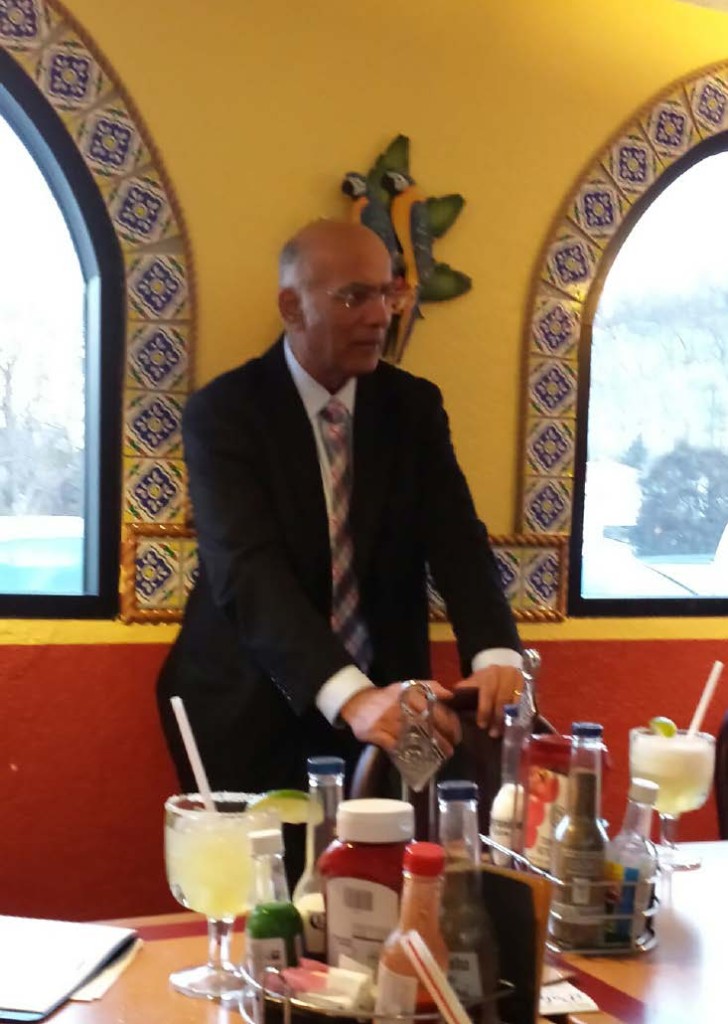


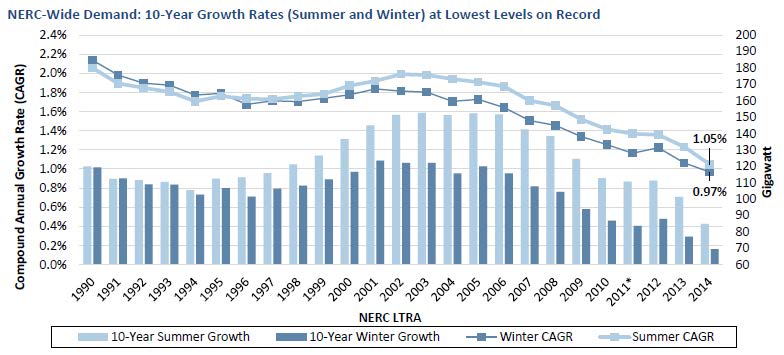
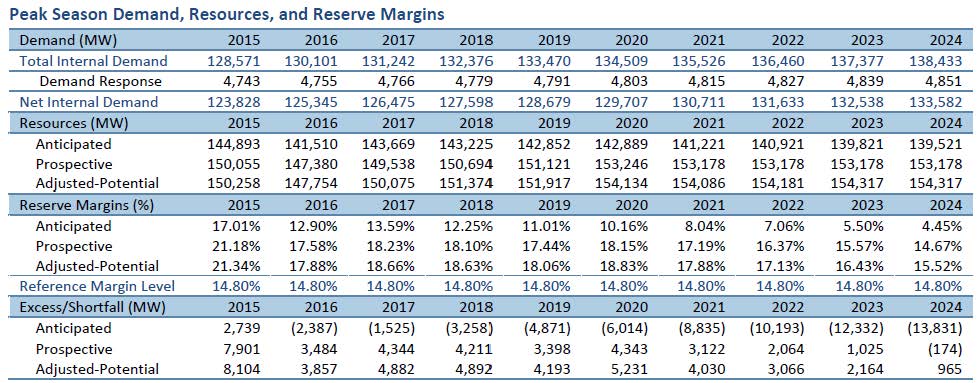
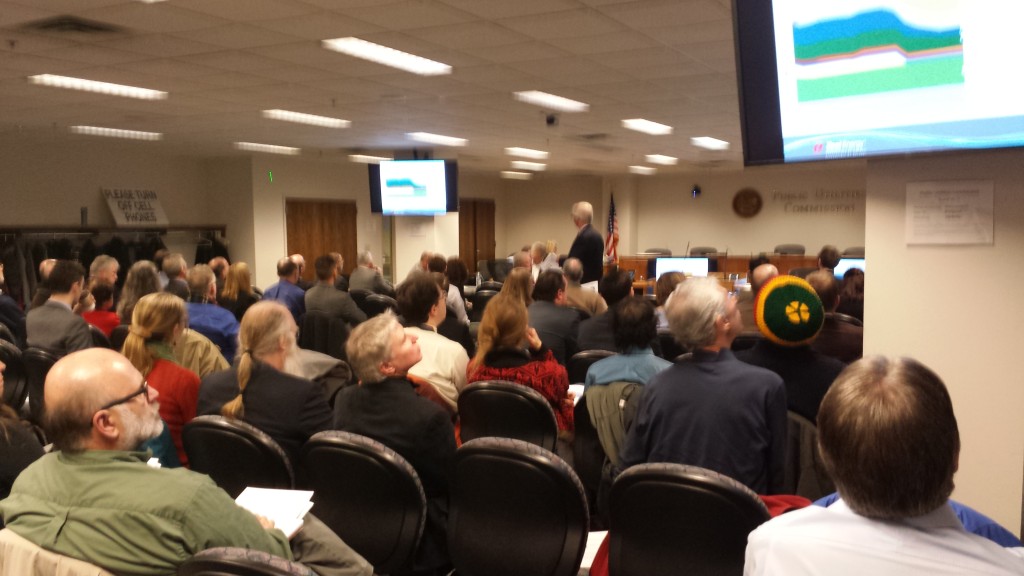
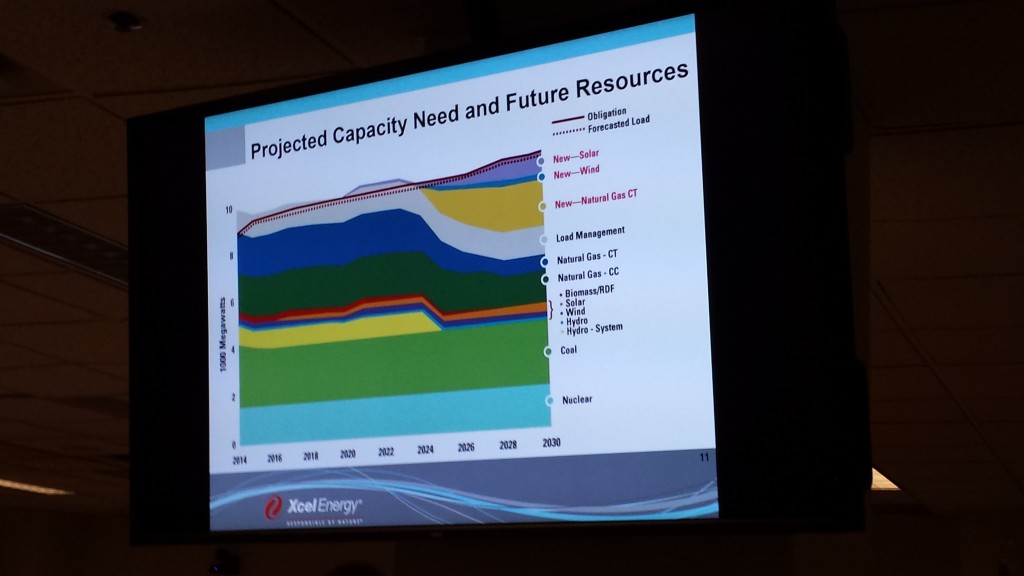
![20150210_103218[1]](https://legalectric.org/f/2015/02/20150210_1032181-1024x576.jpg)

